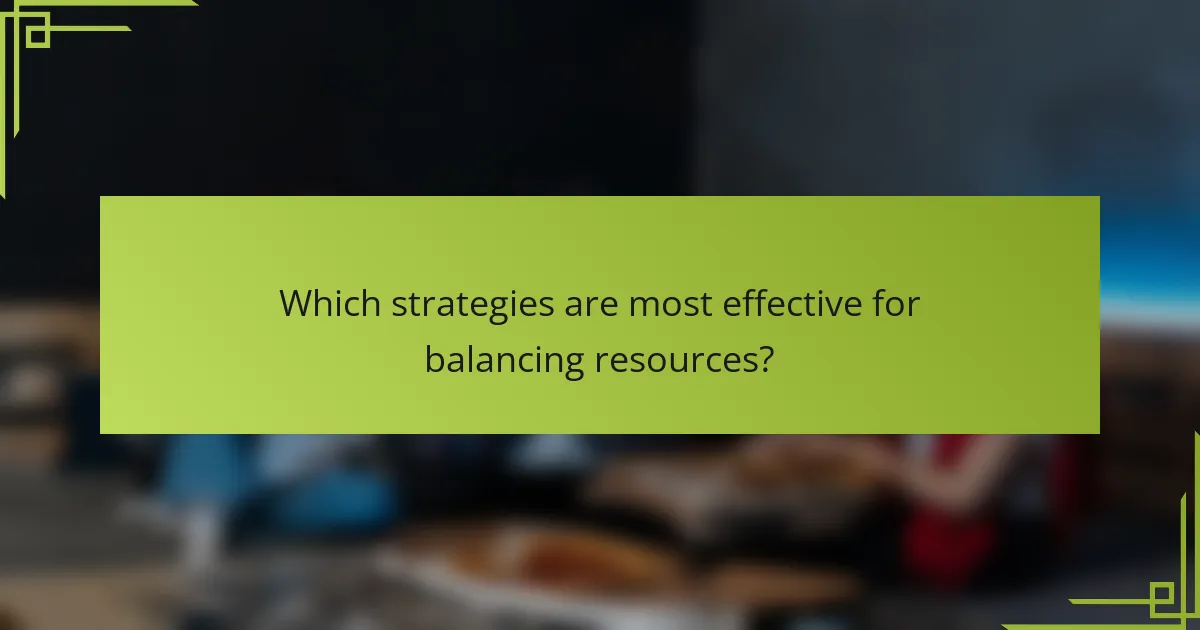In Frostpunk, players confront the challenge of balancing community needs against resource scarcity in a harsh, frozen world. Key gameplay mechanics involve resource management, infrastructure development, and addressing evolving citizen demands. The article explores effective strategies for resource allocation, the impact of moral choices on community morale, and the unique challenges presented by dynamic weather conditions. Understanding these elements is crucial for ensuring the survival and stability of your city.

What are the core gameplay mechanics of Frostpunk?
Frostpunk’s core gameplay mechanics revolve around balancing community needs and resource scarcity. Players manage a city in a frozen world, making critical decisions about resource allocation, infrastructure development, and citizen welfare.
Key mechanics include gathering resources, constructing buildings, and maintaining hope and discontent levels among citizens. Players face dilemmas that impact survival, such as enforcing laws or prioritizing certain community needs over others. The unique attribute of Frostpunk is its emphasis on moral choices, as decisions have long-term consequences on the city’s fate.
Resource management is crucial, with players needing to balance food, coal, wood, and steel. Each resource serves distinct purposes, influencing survival strategies. The game also features a dynamic weather system, adding to the challenge of sustaining the community.
Ultimately, Frostpunk combines strategy with emotional weight, requiring players to navigate the complexities of leadership in dire circumstances.
How does resource management impact community survival?
Resource management significantly impacts community survival by ensuring essential needs are met while balancing scarce resources. Effective management leads to improved health, morale, and productivity among community members. In “Frostpunk,” players face the challenge of allocating resources like food, coal, and steel to sustain their population. Prioritising resource distribution can prevent discontent and enhance survival chances. As a result, strategic planning and adaptability are crucial for overcoming resource scarcity and maintaining community stability.
What role does temperature play in gameplay dynamics?
Temperature significantly influences gameplay dynamics in Frostpunk by affecting survival strategies and resource management. As temperatures drop, players must balance community needs against dwindling resources. Cold weather increases the demand for heating, impacting coal supplies and food production. Players face unique challenges in maintaining citizen morale while ensuring survival, leading to critical decisions on resource allocation and community policies. For instance, extreme cold may necessitate prioritising heating over other needs, highlighting the game’s core theme of balancing scarcity and community welfare.

How do community needs evolve throughout the game?
Community needs in Frostpunk evolve as players face changing environmental challenges and resource limitations. Initially, basic survival needs dominate, but as the game progresses, demands shift towards more complex social and emotional requirements.
As players advance, citizens begin to seek improved living conditions, healthcare, and social justice. Balancing these needs against dwindling resources becomes crucial. For instance, while food and shelter are essential at the start, later stages require addressing hope and discontent levels to maintain a stable society.
The unique attribute of Frostpunk lies in its dynamic decision-making, where player choices directly impact community morale and survival. Rare events, like extreme weather or disease outbreaks, can suddenly alter priorities, forcing players to adapt their strategies rapidly.
Ultimately, understanding the evolution of community needs is vital for effective resource management and ensuring the city’s longevity.
What are the primary social dilemmas players face?
Players in Frostpunk face dilemmas like prioritising resource allocation, managing citizen discontent, and balancing survival with ethical choices. These challenges often force players to choose between immediate community needs and long-term sustainability. For instance, investing in healthcare may reduce workforce efficiency, while focusing on food production can lead to social unrest. The tension between individual welfare and collective survival highlights the unique attributes of decision-making in a resource-scarce environment.
How do player choices affect citizen morale?
Player choices significantly influence citizen morale in Frostpunk. Decisions regarding resource allocation, laws, and community engagement directly affect happiness and stability.
Prioritising food and shelter boosts morale, while harsh laws can lead to discontent. Balancing individual needs against resource scarcity is crucial. For instance, choosing to implement a child labour law can provide immediate resource benefits but may lower overall morale due to ethical concerns.
Citizens react dynamically to player choices, creating a complex feedback loop. Satisfied citizens may contribute more effectively to society, while unhappy ones can lead to unrest. Understanding this relationship helps players maintain a stable community amidst challenges.

Which strategies are most effective for balancing resources?
Effective strategies for balancing resources in Frostpunk involve prioritising community needs, optimising resource allocation, and planning for future demands. Focus on gathering essential resources like coal and food early in the game. Establish a balance between worker efficiency and citizen satisfaction to maintain stability. Utilise technology upgrades to improve resource production and management. Implement laws that enhance worker morale while ensuring essential services are met. Regularly assess resource levels to adapt strategies as challenges arise.
What are the best practices for resource allocation?
To effectively allocate resources in Frostpunk, prioritise community needs, balance scarcity, and ensure survival. Focus on these best practices:
1. Assess immediate needs: Evaluate food, shelter, and healthcare demands.
2. Plan resource gathering: Optimise coal, steel, and wood collection based on current shortages.
3. Implement efficient policies: Use laws to enhance productivity and manage citizen morale.
4. Adapt to changing conditions: Monitor weather and population shifts to adjust allocations accordingly.
How can players prioritise community needs without depleting resources?
Players can prioritise community needs by implementing strategic resource management. Focus on gathering essential resources while balancing the population’s demands.
Start by assessing immediate needs, such as food and shelter. Allocate resources to these areas first to ensure survival. Use the “Hope” and “Discontent” metrics to gauge community satisfaction.
Encourage efficient use of resources through technological advancements. Researching upgrades can enhance resource production and reduce waste.
Lastly, engage the community in decision-making. This fosters a sense of ownership and can lead to more sustainable resource allocation.

What unique challenges do different scenarios present?
Different scenarios in Frostpunk present unique challenges that affect community balance and resource management. Harsh weather conditions can lead to rapid resource depletion, forcing players to prioritise survival strategies. Population dynamics introduce complexities, such as managing health and discontent levels. Additionally, moral dilemmas challenge players to make tough decisions that impact community cohesion and resource allocation. Each scenario demands a tailored approach to overcome these multifaceted challenges effectively.
How do player decisions shape the outcome of each scenario?
Player decisions significantly influence scenario outcomes in Frostpunk through resource management and community dynamics. Choices regarding resource allocation, law enforcement, and community welfare directly impact survival rates and overall city stability. For example, prioritising food production can alleviate hunger but may deplete coal reserves faster. Each decision creates a ripple effect, shaping the community’s morale and resilience. Balancing immediate needs with long-term sustainability is essential for navigating the harsh environment effectively.
What rare events can significantly alter gameplay?
Rare events in Frostpunk can drastically change gameplay, impacting community survival and resource management. Events such as sudden temperature drops can force players to adapt quickly. Additionally, the arrival of unexpected refugees may strain resources and require immediate decision-making. Natural disasters, like storms, can disrupt supply chains and damage infrastructure. Lastly, unique scenarios, such as the discovery of a hidden cache of resources, can provide critical advantages or lead to moral dilemmas. Each of these events requires strategic thinking to maintain balance between community needs and resource scarcity.

How does Frostpunk reflect real-world themes of resource scarcity?
Frostpunk effectively mirrors real-world themes of resource scarcity through its gameplay mechanics and narrative choices. Players must make difficult decisions to balance community needs against limited resources, reflecting real societal challenges. The game emphasises the importance of resource management, illustrating how scarcity can lead to moral dilemmas and societal breakdown. As players navigate these choices, they confront themes of survival, governance, and the impact of leadership, highlighting the complexities of managing resources in dire circumstances. This connection to real-world issues enhances the game’s depth and relevance.
What parallels can be drawn between the game and societal issues?
Frostpunk illustrates the struggle between community needs and resource scarcity, mirroring real-world societal challenges. Players must make difficult decisions that reflect the balance between individual rights and collective survival. For instance, prioritising food distribution over energy can lead to unrest, paralleling societal debates on resource allocation. The game’s mechanics highlight the impact of leadership choices on community morale, similar to how governance affects societal cohesion. Ultimately, Frostpunk serves as a commentary on the ethical dilemmas faced in resource-limited environments.
How does the game encourage critical thinking about community welfare?
Frostpunk encourages critical thinking about community welfare by forcing players to make tough decisions that impact survival. Players must balance resource scarcity with the needs of citizens, prioritising health, hope, and safety. Each choice affects morale and productivity, prompting reflection on ethical implications. The game simulates real-world dilemmas, fostering awareness of community interdependence and the consequences of leadership decisions.

What expert tips can enhance gameplay experience?
To enhance gameplay experience in Frostpunk, focus on strategic resource management and community satisfaction. Prioritise balancing food, heat, and hope to maintain stability.
1. Monitor resource levels closely to avoid shortages.
2. Invest in technology upgrades to improve efficiency.
3. Engage with citizens to understand their needs and concerns.
4. Plan for future expansions to accommodate growing populations.
What common mistakes should players avoid?
Players should avoid neglecting community needs, overextending resource management, and failing to plan for future events. Prioritising one aspect can lead to disaster. For example, focusing solely on food production may cause discontent due to lack of warmth or healthcare. Balancing these elements is crucial for survival. Additionally, underestimating the impact of discontent can result in rebellion, crippling the community’s functionality. Always monitor citizen happiness while managing resources effectively to maintain stability.
How can players optimise their strategies for long-term success?
Players can optimise their strategies for long-term success in Frostpunk by focusing on community needs and efficient resource management. Prioritise balancing heat, food, and health to maintain citizen morale.
1. Assess resource availability regularly to avoid shortages.
2. Invest in technology that enhances resource production and efficiency.
3. Adapt policies to meet changing community demands and crises.
4. Plan city layout strategically to minimise resource transport time.
By implementing these strategies, players can ensure a sustainable and thriving community.